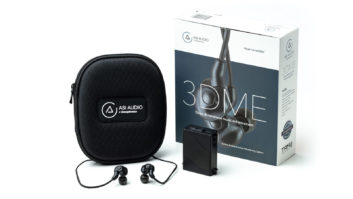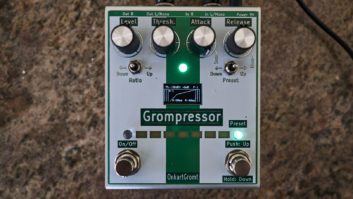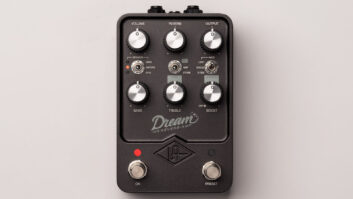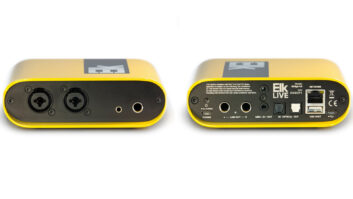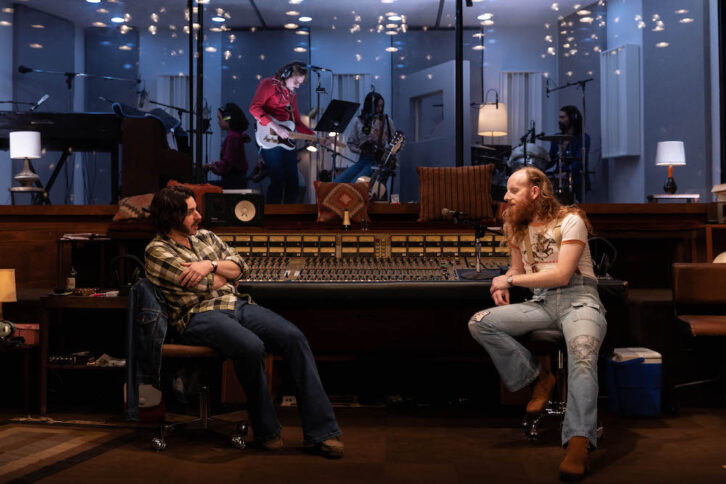
New York, NY (November 10, 2023)—The new Off-Broadway play, Stereophonic, has been garnering rave reviews for its portrayal of a rock band’s year-long quest to record the follow-up to its breakthrough album. If not as staggering as some say—The New York Times made it a Critics Pick while The Washington Post simply labeled it “the best play of 2023”—it is nonetheless quite entertaining, with a terrific cast, a set that is a technological marvel and a slew of strong songs that puts the wind in its sails.
David Adjmi’s play, set inside woody 1970s studios in Sausalito, CA and Los Angeles, follows a half-British, half-American group as it tears itself apart and patches itself back together again in the name of the creative process. All the while, a pair of engineers witness the turmoil, alternately taking on the roles of spectators, enablers and occasionally both emotional and physical punching bags for their increasingly ragged clients.
Underlining the proceedings is David Zinn’s clever set. Upstage, a sterile live room can be seen through floor-to-ceiling glass, looming above the comparatively funky control room downstage. Designed in a sunken living room-style, the space is an inspired choice, simultaneously recalling the 1970s and providing plenty of settings for bandmembers to argue in while keeping the cold, clinical live room visible at all times. The result is an intimate set that places the audience at the heart of the recording process, so close that you literally smell the cigarettes being stubbed out in the control room.
At the center of it all is a massive 32-channel analog console (likely a vintage Cadac), both the main tool and taskmaster of the proceedings. Throughout the show, the gear informs the veracity of the play—the band uses what appear to be working mics in the live room, and engineers Grover (Eli Gelb) and Charlie (Andrew R. Butler) repeatedly putter over the desk and its patch bay. In fact, the tension rises considerably at one point when Charlie has to make anxious 4 AM calls in search of a replacement module for the console. Throughout, there are details like that which lend an air of you-are-there authenticity, such as when the set’s inconspicuous tape machine appropriately starts, stops and rewinds in the background during a string of tension-filled failed takes. Working hand-in-hand with the audio technology on display is Ryan Rumery’s impressive sound design, which not only navigates dialogue and on-stage musical performances but also helps shift the audience’s attention back and forth between different rooms.
While not a musical, by necessity the play involves a number of songs performed by the cast and written by Will Butler, formerly of Arcade Fire. Conjuring the SoCal aesthetic of the era without devolving into pastiche, they play a crucial role in the production, serving as a focus and sometimes counterpoint for the action onstage.
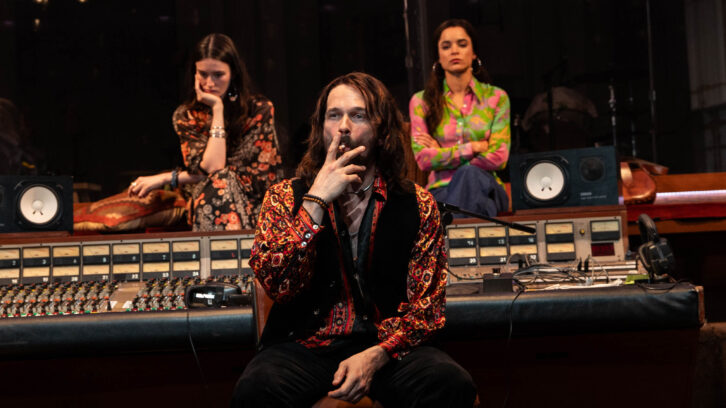
Making the most of its leisurely three-hour-plus runtime, Stereophonic derives high drama from a variety of places—not just the ever-dependable themes of sex, drugs and rock n’ roll, but also something as simple as when drummer Simon (Chris Stack) balks at using a click track or struggles to tune his kit so that the snare doesn’t rattle. However, while playwright Adjmi has a lot to say about the ugly, often mundane aspects of the creative act versus the polished sheen of the finished product—the artifice of art itself—those ideas sometimes struggle to break free of the context they’re delivered in.
If the plot’s framework sounds eerily familiar, that’s because it’s a near-slavish retelling of the well-documented turmoil that a well-known real-life band endured while recording its 40 million-plus selling opus during the same period as the play. It’s not merely that the two couples in the band break up over the course of the play, as does Simon with his unseen wife, or that the real-life band recorded at the legendary Record Plant in Sausalito before decamping to Wally Heider Recording in Los Angeles. It’s that the drummer and bassist co-manage the band. It’s that the female band members move out to live in nearby condos while the men share a house together. It’s that the guitarist re-records the bassist’s parts because they’re too showy, attacks one of the engineers for recording over a solo as ordered, and has a brother who’s an Olympic medalist swimmer. It’s that one of the engineers gets promoted to co-producer halfway through the album (though in real life, both engineers were). It’s that the ingenue female singer is forced to drop one of her songs from the running order because the album’s too long, and later preps for a solo career. It’s many things…and that hurts a play that ostensibly wants to talk about creativity.
Occasionally the adherence works to the material’s advantage, such as when bassist Reg (Will Brill) drunkenly slurs “I want to live in art” in the middle of a comedic rant about houseboats. The moment stands out as much for its meta surroundings—he doesn’t realize the band’s lives are becoming their art—as it does for its sudden, soul-baring poignancy. Comparatively, instants that use the real-life story as a jumping-off point are few.
To their credit, the cast members work hard to make the characters their own, and avoid any affectations that could be considered an imitation of the real-world band members. In addition to having to portray people going through rough emotional terrain over the course of a year, they also have to turn in pro-level musical performances throughout—a crucial aspect for a story like this—and they succeed winningly. Juliana Canfield infuses her character, long-suffering keyboardist Holly, with a weary hopefulness, while Sarah Pidgeon uses her showstopping voice to great effect as Diana, and Tom Pecinka brings an air of subtle menace to guitarist Peter. While Gelb and Butler’s engineers are often relegated to comic relief, they too get their dramatic moments, with Gelb in particular deftly telegraphing his character’s journey without saying a word as he mixes at the console in the play’s final moments.
Stereophonic is an ambitious undertaking, bringing an epic-length story in a logistically complicated setting to the stage in a way that feels inviting to both those who know the recording world well and those who have never set foot in a studio. Behind-the-glass pros will leave feeling they’ve been “seen” and music fans—particularly aficionados of That Band—will come away with a deeper appreciation for the alchemy of the studio.
• • •
‘Stereophonic’ is at Playwrights Horizons in New York City through December 17, 2023.
